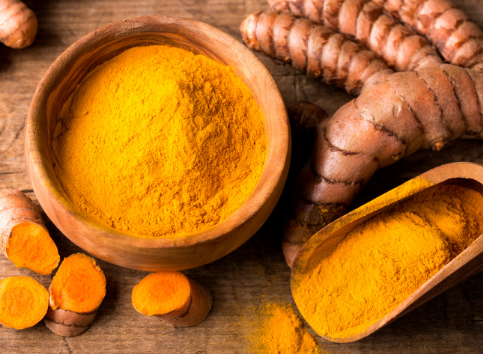Turmeric: The golden source of anti-inflammatory and antioxidant benefits
Published Oct 19, 2024 • By Somya Pokharna
The vibrant golden-yellow spice, turmeric, has been treasured for over 4,000 years as a cooking ingredient, natural dye, and herbal remedy. Traditionally used in Ayurvedic and Chinese medicine, turmeric has made its way into modern health practices as a dietary supplement and functional food ingredient, thanks to the host of health benefits offered by its active ingredient, curcumin.
So, what are the health benefits of turmeric, and how does it work? Which chronic conditions can it help manage? Does it have any side effects?
Let’s get to the root of this golden spice in this article!

What is turmeric? How does it impact the body’s physiology?
Turmeric, scientifically known as Curcuma longa, is derived from the root of a plant in the ginger family. Originally cultivated in Southeast Asia, it is not only a staple in Indian cuisine as an earthy component of curry powders, but it can also be consumed in various forms, such as fresh root, capsules, and concentrated extracts.
The key compound responsible for its medicinal effects is curcumin, a type of curcuminoid that has potent anti-inflammatory and antioxidant properties. Other bioactive components include demethoxycurcumin and bisdemethoxycurcumin, which also contribute to its health benefits.
What chronic conditions might benefit from turmeric?
Turmeric’s versatile properties make it a popular supplement for various chronic conditions. Here’s how it may help:
Arthritis and joint pain
Curcumin’s anti-inflammatory effects can reduce joint swelling, pain, and stiffness in people with osteoarthritis and rheumatoid arthritis. In several studies, curcumin was found to be as effective as some nonsteroidal anti-inflammatory drugs (NSAIDs) like ibuprofen but with fewer side effects.
Cardiovascular health
Curcumin can lower LDL cholesterol and prevent plaque build-up in the arteries, reducing the risk of atherosclerosis, a major cause of heart attacks and strokes. By enhancing endothelial function, or the health of blood vessel linings, curcumin also helps control blood pressure.
Diabetes and metabolic syndrome
For people with type 2 diabetes or metabolic syndrome, curcumin improves insulin sensitivity and helps regulate blood sugar levels. Its anti-inflammatory properties reduce the risk of complications such as neuropathy and nephropathy.
Neurodegenerative diseases
Curcumin’s ability to cross the blood-brain barrier means it can target inflammation and oxidative stress in the brain. It has been shown to reduce the formation of amyloid plaques associated with Alzheimer’s disease and may slow cognitive decline in older adults.
Cancer prevention and treatment
Curcumin’s anticancer properties include inhibiting the growth of cancer cells, preventing metastasis, and promoting apoptosis (programmed cell death) in tumors. Studies suggest it may be effective in colon, breast, and prostate cancers, making it a promising adjunct to conventional therapies.
Digestive health
Turmeric’s role in digestive health is well documented, especially in managing IBD, ulcerative colitis, and gastritis. It reduces inflammation in the gut lining and protects against ulcers.
With all these potential benefits, one may ask why curcumin is not used more widely in medical treatments?
Why is curcumin hard for the body to absorb?
One of the biggest problems with curcumin’s therapeutic use is its poor bioavailability. This means that it’s not easily absorbed by the body and when you take it, only a small amount actually gets into your bloodstream to have any effect. This is due to its rapid metabolism and elimination from the body.
Several strategies have been developed to enhance curcumin’s absorption, including:
- Adding Piperine, a natural compound found in black pepper. When combined with curcumin, it can increase its absorption by up to 2000% by inhibiting its breakdown in the liver.
- Taking curcumin with fats like oils to help it dissolve better in the digestive tract.
- Using special formulations (e.g., nanoparticles) to improve its stability and absorption, making it more effective at lower doses.
What are the side effects of turmeric and curcumin?
While turmeric is generally safe when used in culinary amounts, high doses of curcumin (more than 4 grams per day) can cause side effects such as nausea, diarrhea, and stomach cramps. Other potential concerns include:
- Curcumin can interact with and enhance the effects of blood-thinning medications like warfarin, increasing the risk of bleeding.
- Turmeric can worsen symptoms in people with gallbladder issues like gallstones or bile duct obstruction.
- High doses of curcumin are not recommended during pregnancy and breastfeeding as they may stimulate uterine contractions or alter hormone levels.
- For individuals with diabetes, curcumin may lower blood sugar levels, which could interact with diabetic medications.
How can turmeric be used safely for health benefits?
To safely incorporate turmeric into your diet and reap its benefits, start with dietary sources and add turmeric to your daily meals. Use it in smoothies, curries, teas, soups, or golden milk (a blend of turmeric, milk, and spices).
If using supplements, cautiously choose standardized extracts containing 95% curcumin with piperine. Begin with a low dose (e.g., 500 mg per day) and gradually increase based on tolerance. ALWAYS discuss with your doctor before starting supplements, especially if you have a chronic condition or take other medications.
Ultimately, while turmeric is a valuable addition to a healthy lifestyle, it should be viewed as a complementary rather than a primary treatment. More high-quality research is needed to fully understand its therapeutic potential.
Did you find this article helpful?
Give it a “Like” and share your thoughts and questions with the community in the comments below!
Take care!
Sources:
7 Health Benefits of Turmeric — Cleveland Clinic
Dusabumuremyi, J. C., Duhoranimana, E., & Chen, X. (2022). Health benefits of turmeric and ginger. Handbook of Nutraceuticals and Natural Products: Biological, Medicinal, and Nutritional Properties and Applications, 2, 259-268.
Hay, E., Lucariello, A., Contieri, M., Esposito, T., De Luca, A., Guerra, G., & Perna, A. (2019). Therapeutic effects of turmeric in several diseases: An overview. Chemico-biological interactions, 310, 108729.
Jaiswal, S. G., & Naik, S. N. (2021). Turmeric oil: composition, extraction, potential health benefits and other useful applications. Avicenna Journal of Medical Biochemistry, 9(2), 93-106.
Jovičić, D., Jozinović, A., Grčević, M., Spaseska Aleksovska, E., & Šubarić, D. (2017). Nutritional and health benefits of curcumin. Hrana u zdravlju i bolesti: znanstveno-stručni časopis za nutricionizam i dijetetiku, 6(1), 22-27.
Kaur, A. (2019). Historical background of usage of turmeric: A review. Journal of Pharmacognosy and Phytochemistry, 8(1), 2769-2771.
Kocaadam, B., & Şanlier, N. (2017). Curcumin, an active component of turmeric (Curcuma longa), and its effects on health. Critical reviews in food science and nutrition, 57(13), 2889-2895.
Lal, B. (2021). A review study on benefits of turmeric. ACADEMICIA: An International Multidisciplinary Research Journal, 11(12), 547-553.
Mata, I. R. D., Mata, S. R. D., Menezes, R. C. R., Faccioli, L. S., Bandeira, K. K., & Bosco, S. M. D. (2021). Benefits of turmeric supplementation for skin health in chronic diseases: a systematic review. Critical Reviews in Food Science and Nutrition, 61(20), 3421-3435.
Munekata, P. E., Pateiro, M., Zhang, W., Dominguez, R., Xing, L., Fierro, E. M., & Lorenzo, J. M. (2021). Health benefits, extraction and development of functional foods with curcuminoids. Journal of Functional Foods, 79, 104392.
Rathaur, P., Raja, W., Ramteke, P. W., & John, S. A. (2012). Turmeric: The golden spice of life. International Journal of pharmaceutical sciences and research, 3(7), 1987.
Sahoo, J. P., Behera, L., Praveena, J., Sawant, S., Mishra, A., Sharma, S. S., ... & Samal, K. C. (2021). The golden spice turmeric (Curcuma longa) and its feasible benefits in prospering human health—a review. American Journal of Plant Sciences, 12(3), 455-475.
Singletary, K. (2010). Turmeric: an overview of potential health benefits. Nutrition Today, 45(5), 216-225.
Timba, P. P., Giri, S. G., & Panchal, R. V. (2019). Health benefits and possible risks of turmeric, garlic and ginger: a short. Health, 6(4), 4656-4659.
Turmeric — Icahn School of Medicine at Mount Sinai
Turmeric — National Center for Complementary and Integrative Health (NCCIH)
Turmeric Benefits — Johns Hopkins Medicine
Turmeric benefits: A look at the evidence — Harvard Health Publishing
Verma, R. K., Kumari, P., Maurya, R. K., Kumar, V., Verma, R. B., & Singh, R. K. (2018). Medicinal properties of turmeric (Curcuma longa L.): A review. Int. J. Chem. Stud, 6(4), 1354-1357.
Yadav, L. (2022). Golden Spice Turmeric and Its Health Benefits. In Ginger-Cultivation and Use. IntechOpen.
Comments
You will also like

Spoon theory: What is it and how can it help people living with chronic illness?
Apr 13, 2022 • 7 comments

 Facebook
Facebook Twitter
Twitter

